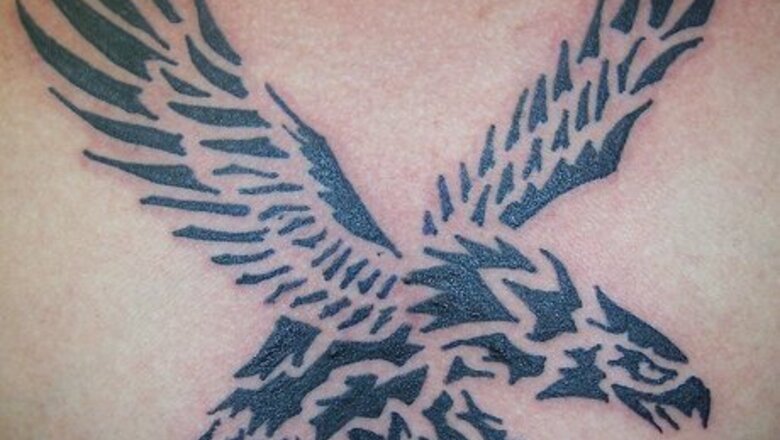
views
The first stage of tattoo healing is 1-2 days after you get it; the tattoo will ooze blood, ink, and plasma. Stage 2 occurs 1-2 weeks after and is marked by irritated or flaking skin. Stage 3 happens 2-4 weeks after and is accompanied by scabs and peeling skin. The last stage, 4 weeks after and beyond, is when your tattoo is completely healed.
The Healing Stages of a New Tattoo
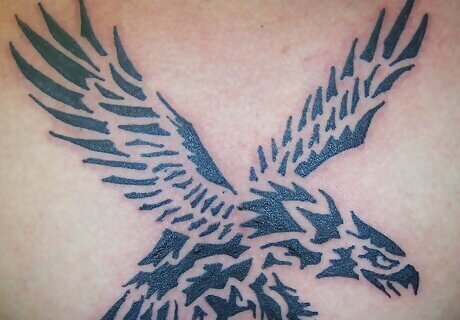
Stage 1: Inflammation and oozing (2-4 days after tattoo) From the moment you leave the chair to about 2-4 days later, your tattoo will ooze excess ink, plasma, and blood as your body reacts to the new wound. Your skin will also likely be red and feel somewhat sore, and a little redness and swelling are to be expected. It’s totally natural and nothing to worry about—just keep the initial bandage on for 1-2 days to keep your tattoo protected and to give its healing process a head start. Typically, oozing, red, or raised skin lasts not longer than about 2 weeks if you keep your tattoo clean and cared for.

Stage 2: Itching and irritation (1-2 weeks after tattoo) During stage 2, you'll experience itching and irritation and both are totally normal. About a week or 2 after you get your tattoo, your tattoo may become itchy or slightly flaky, which is a normal immune response and a sign your body is on-track for healing. Itching and irritation often recede after about 2 weeks. That said, large, raised hives or painful rashes aren’t typical, so see a doctor if you notice these.

Stage 3: Scabbing and peeling (2-4 Weeks after Tattoo) During stage 3, you’ll develop dry patches of flaky skin, as well as scabs, both of which are also typical in the healing process. Your tattoo will also start to peel as the top layer of skin sloughs off and reveals the fresh layer beneath it. This stage usually starts one to two weeks after you get your tattoo, peaks, and ends around four weeks after you get your tattoo. It also often overlaps with stage 2. Let your skin peel off naturally and avoid picking those scabs. Allowing your skin to do its thing is important for proper healing.
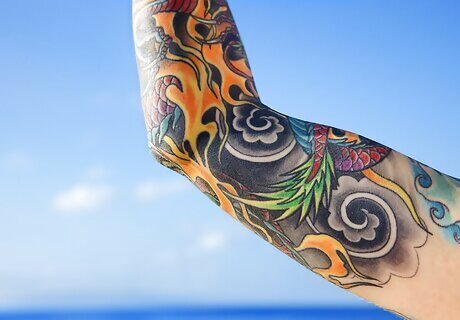
Stage 4: Long-term healing (4 weeks after tattoo and beyond) During stage 4, your tatted skin is considered fully healed after a minimum of 2 weeks, provided you’ve taken good care of it. That means no more redness, peeling, or other hallmarks of the tattoo healing process. That said, every tattoo and body are different, so it may even take 4 weeks or more to reach this stage. By about 3 months after you get your tattoo, all layers of your skin should be fully healed with no lingering soreness, redness, irritation, or other complications. Your tattoo journey isn’t over! Keep applying sunscreen and moisturizer regularly to keep your tattoo looking sharp and vivid for years to come.
How long does it take for a tattoo to heal?
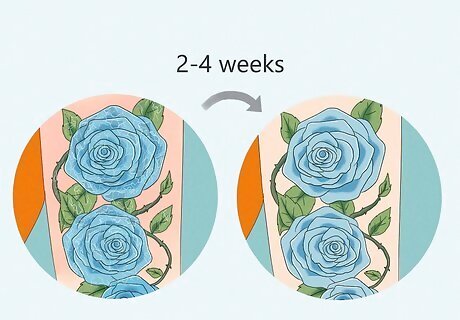
Most tattoos usually take about 2-4 weeks to fully heal. After about 3 weeks, your skin will likely look totally normal again (with the addition of a sick tat) and you can do all the stuff you couldn’t while it was healing, like swimming or intense exercise. But that’s just an average, and everyone’s timeline is different. That’s why it’s vital to follow your tattoo artist’s advice for aftercare, as they can often personalize your routine for your skin type and tattoo. What’s more, your tattoo may take longer to heal depending on its size, location, and even the color of ink that was used. It takes the lower layers of skin about 3-4 months to fully recover, but this is long after you have to be worried about your new ink. Healing may take longer if you experience complications like an allergic reaction, inflammation, or infection during your healing process.
Helping Your Tattoo Heal Faster

Follow your tattoo artist’s immediate aftercare instructions. Your tattoo artist is a professional, and they know what they’re talking about. They’ll often be able to provide specific and personalized aftercare tips based on the size and location of your specific tattoo, and it’s important to follow those aftercare tips to the letter to properly care for your new tattoo. Your artist wants to see their work preserved and looking fresh as much as you do, so follow their advice! Your artist will also likely have advice for how long to keep the initial wrap on, preferred ointment brands that they trust, and pain management strategies for tattoos in awkward places.
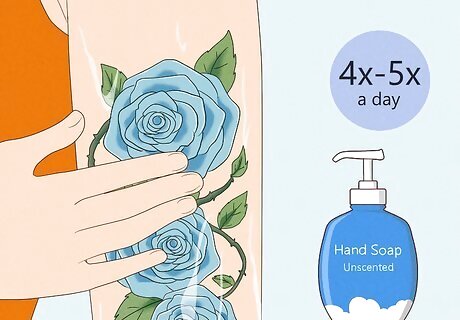
Wash your tattoo 4-5 times a day with unscented hand soap. After you take off the initial bandage (usually 10-24 hours after sitting for the tattoo), wash your hands with warm water and mild hand soap. Then, wash your tattoo with warm water and mild, unscented hand soap, using just your fingertips. Gently pat it dry with a paper towel to make sure no moisture lingers on your skin. Repeat this 4-5 times a day (or however often your tattoo artist recommends) to keep your tattoo clean and sterile. Avoid overly thick formulas that may smother your tattoo, like Vaseline, as well as greasy formulas like those with vitamin E or aloe.
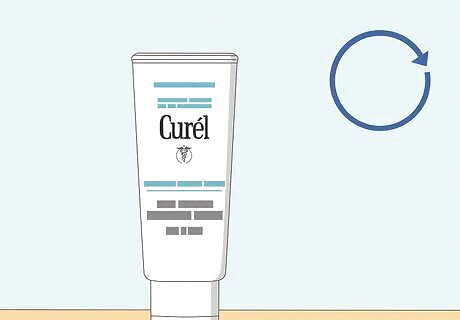
Keep your tattoo moisturized at all times. After each time you wash your tattoo, apply lightweight moisturizer in a thin layer over the tattoo to help your skin as it heals. Use a mild lotion like Curel, Aquaphor, or Cetaphil. Or, use a specially formulated tattoo balm to make sure your tattoo gets the best treatment. Ask your tattoo artist which lotion they recommend. They may even offer you a sample tube of lotion or tattoo balm.
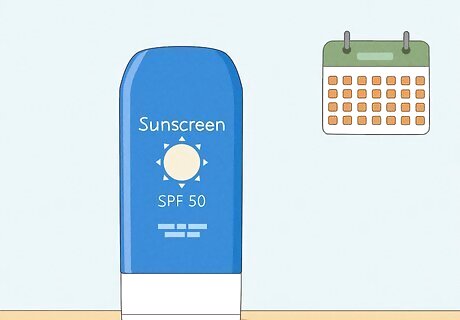
Wear sunscreen every day to protect your healed tattoo. Once your tattoo is fully healed, apply a generous amount of sunscreen every time you plan to spend time outside to lessen any long-term fading. SPF 50 will have you covered, but feel free to use a stronger formula (especially if you have fair skin). While your tattoo is healing, protect it from the sun by covering it with loose-fitting clothing, if possible.

Avoid intense exercise or submerging your tattoo in water. During the first 3-4 weeks of healing, avoid dipping your tattoo in water (not including showers) or sweating profusely. Your new tattoo is essentially an open wound, and open water like pools, lakes, the ocean, or even baths are hotbeds for bacteria that may enter the tattoo and cause infections. The same goes for sweat you produce while exercising.

Avoid picking at flakes or scabs. We won’t sugarcoat it: you’re going to want to pick, itch, and scratch at that new tattoo, especially when it’s in its peeling and scabbing stages. Resist! Your skin is naturally healing itself, and if you pick or itch the tattoo, you risk removing any scabs or dead skin before they’re ready to come off, possibly damaging your tattoo. To stop your tattoo from itching, lightly tap it with 2-3 fingers for instant relief. Or, dampen a towel with cool water and lightly press it to the tattoo for 5 minutes.
Signs Your Tattoo Isn’t Healing Properly
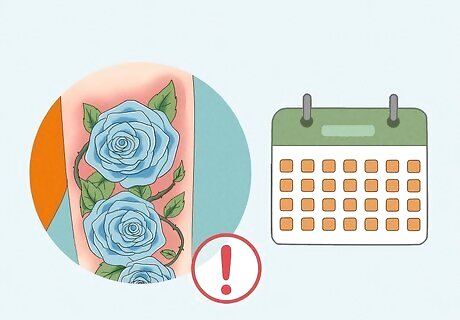
Redness that lasts longer than a couple of weeks Persistent redness may be a sign of infection, especially when it’s accompanied by worsening pain or soreness, or painful bumps or rashes on or around the tattoo. Consult a doctor as soon as you can to treat it, which not only alleviates your pain but can help preserve your tattoo. Persistent redness or rashes may also be caused by an allergic reaction to the ink. It’s fairly uncommon, but is more likely if you’re being treated for HIV or have had joint replacement surgery.

Yellow or green fluid seeping from the tattoo Discolored fluid seeping from your tattoo is often a sign of pus or other bodily fluid that isn’t usually present during normal healing. Similarly, open sores or persistent bleeding are also red flags. This is a sign of infection, so talk to a doctor as soon as you can to treat the infected skin. Note that if you have colored ink, your tattoo might peel away in various colors. This is normal, and some pros even have a word for it: “fruity pebbles” peeling, like the cereal!
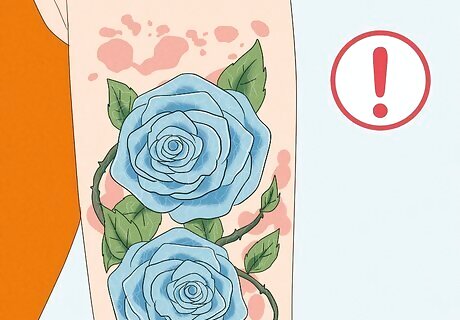
Hives or chronic skin swelling Another common sign of infection or allergic reaction is large, red, raised bumps on or around the tattoo. You may have an allergy relating to the tattoo pigment that’s causing your skin to react negatively to the ink, such as a carbon sensitivity or a cobalt allergy, which can be a complication when working with blue ink, especially. Red or yellow pigments are among the most likely to cause negative skin reactions. In all likelihood, your body may recover from the reaction with little or no damage to the tattoo, but it’s important to see a healthcare provider to aid in recovery.
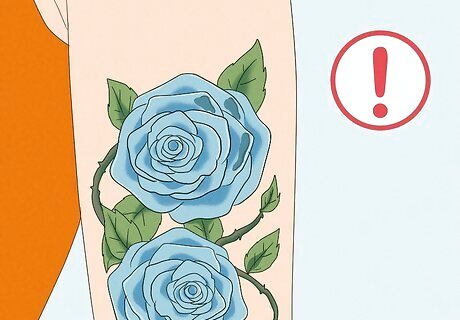
Scarring instead of scabbing Scabs are a common anxiety for the newly tattooed, and are natural and something of a rite of passage. But if your skin starts to develop scars or other disfigurements, it may be a sign of infection, allergic reaction, or another complication. Keloids, or raised skin caused by an overgrowth of scar tissue, are also a possibility. As always, consult a healthcare professional for a diagnosis and treatment.
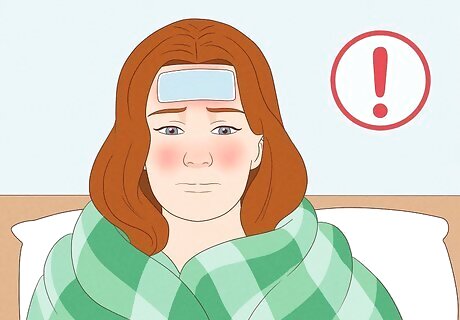
Fever or other illness during your recovery Fever, chills, shivering, or other flu-like symptoms in the hours, days, or weeks after a tattoo are often sure signs of infection, so don’t ignore them. These symptoms may be more serious and point to other health hazards, so speak to a medical professional immediately if you experience them.



















Comments
0 comment